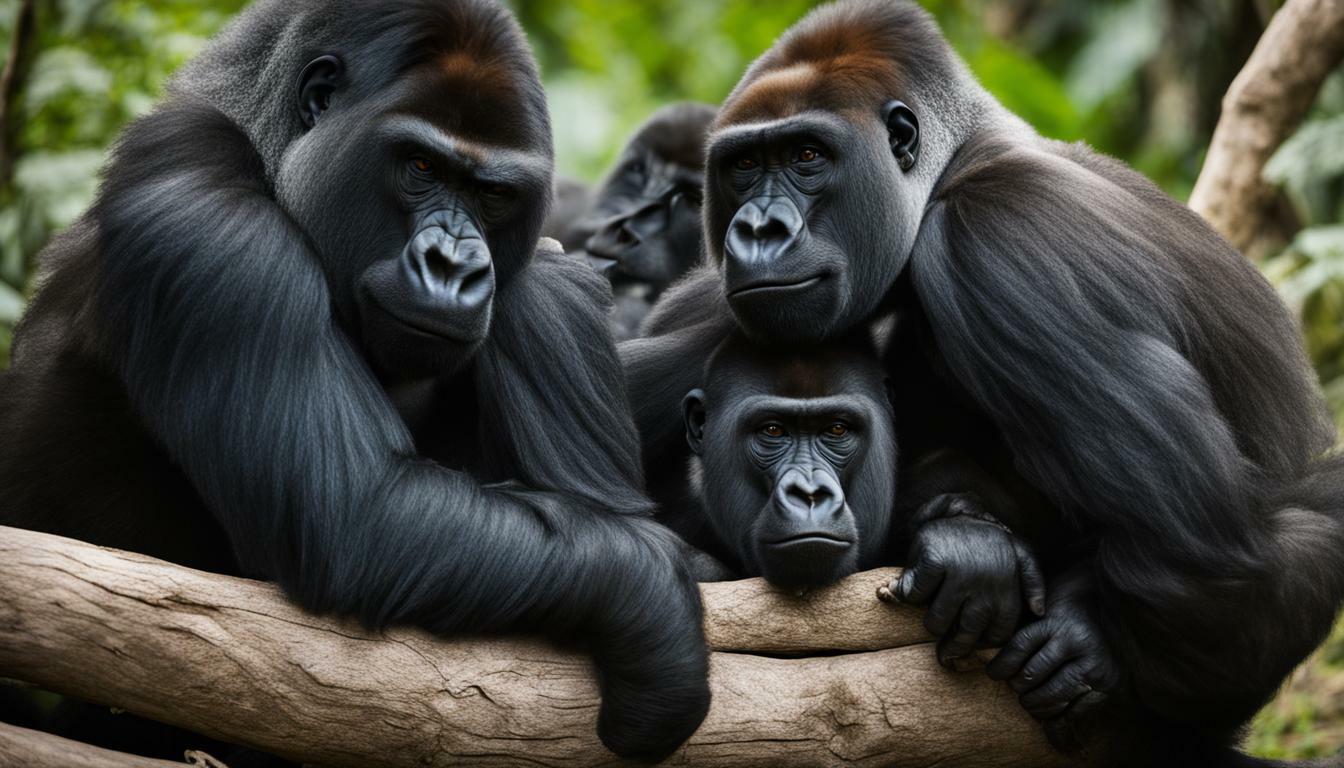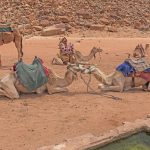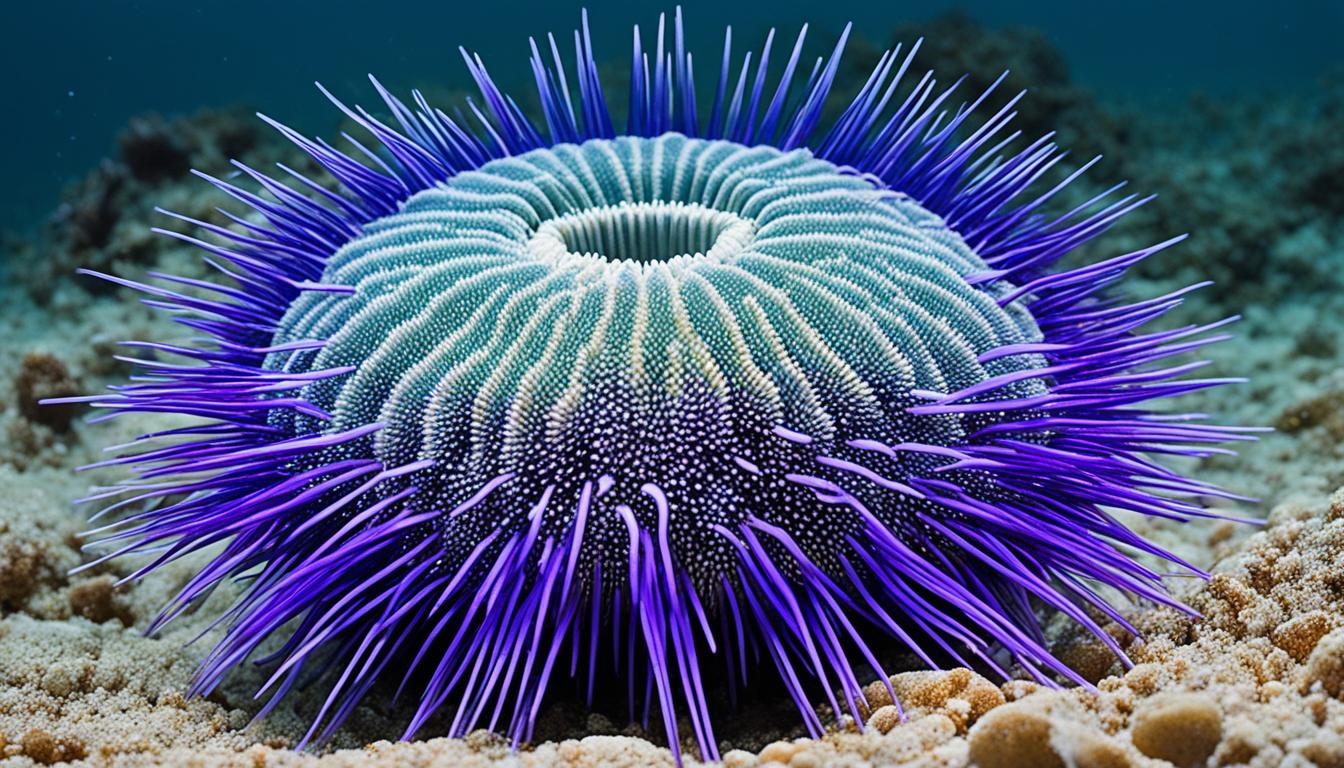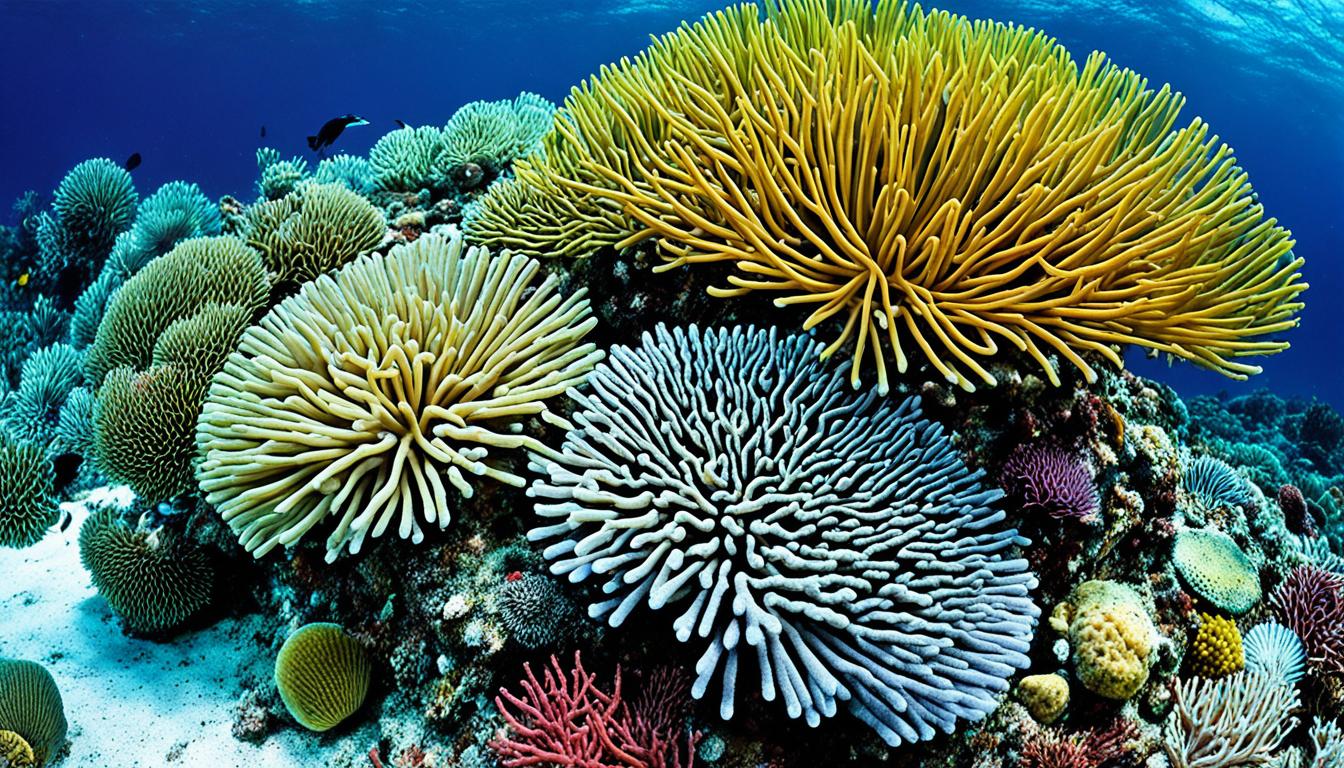Gorillas possess remarkable intelligence and problem-solving skills that rival our own. These gentle giants exhibit cognitive abilities and primate cognition that fascinate and inspire us. In this section, we will delve into the fascinating world of gorilla intelligence, exploring their problem-solving capabilities and the parallels they share with human thinking abilities.
Key Takeaways:
- Gorillas display exceptional problem-solving skills that closely resemble our own.
- They demonstrate intelligence, use tools, and engage in sophisticated communication.
- Gorillas’ social behaviors and complex communication systems are intertwined with their problem-solving abilities.
- They showcase playful adaptability and inventiveness, engaging in make-believe play and creating their own games.
- Gorillas possess impressive memory and recognition abilities, enabling them to identify and recall specific information.
As we explore gorilla intelligence further, we will also delve into their habitat, conservation efforts, threats they face, diet, nest-building behaviors, and exceptional climbing abilities. By understanding and appreciating the specific lifestyles and adaptations of these incredible primates, we can truly appreciate the depth of their intelligence and problem-solving skills.
The Cognitive Abilities of Gorillas
Gorillas exhibit a wide range of cognitive abilities, including problem-solving, tool usage, and advanced communication skills. These highly intelligent animals have captured the fascination of researchers and scientists as they continue to unveil the depth of primate intelligence.
One remarkable aspect of gorilla cognition is their problem-solving skills. They have been observed using tools in the wild, such as using sticks to extract food or test the depth of water before crossing. This ability to manipulate objects to achieve a desired outcome showcases their resourcefulness and ingenuity.
In addition to problem-solving, gorillas possess advanced communication skills. They have a complex system of communication that includes vocalizations, gestures, and facial expressions. It is through these intricate forms of communication that they are able to convey their intentions, emotions, and establish social bonds within their tight-knit family groups. This sophisticated communication further highlights the cognitive abilities of gorillas.
Gorillas also demonstrate an exceptional level of adaptability and creativity. They engage in playful behaviors, including make-believe play and creating their own games. This playful adaptability allows them to explore new strategies and develop innovative approaches to problem-solving. It is through their ability to think outside the box that they showcase their intelligence and inventive nature.
| Cognitive Abilities of Gorillas | |
|---|---|
| Problem-solving skills | Ability to use tools for various purposes |
| Advanced communication | Complex system of vocalizations, gestures, and facial expressions |
| Adaptability and creativity | Engage in make-believe play and create own games |
“Gorillas are not just physically impressive, but mentally as well. Their cognitive abilities continue to astound researchers, revealing the remarkable parallel between human and primate intelligence.” – Dr. Jane Goodall
Social Behaviors and Complex Communication
Gorillas’ problem-solving skills are closely intertwined with their complex social behaviors and communication systems. These highly intelligent animals rely on their social interactions to navigate their environment and overcome challenges. Gorillas live in tight-knit family groups led by a dominant silverback male, with females and their offspring forming strong family bonds. Within these social groups, gorillas engage in a variety of behaviors that contribute to their problem-solving abilities.
Communication plays a vital role in gorilla society, with these remarkable primates utilizing a complex system of vocalizations, gestures, and facial expressions to convey information. Researchers have identified over 25 distinct vocalizations used by gorillas, ranging from grunts and hoots to barks and roars. These vocalizations serve various purposes, including expressing emotions, establishing dominance, and coordinating group movements. Additionally, gorillas use gestures such as chest beating, stomping, and arm swings to communicate non-verbally.
One fascinating aspect of gorilla communication is their use of facial expressions. By subtly changing their facial muscles, gorillas can convey a wide range of emotions and intentions to their fellow group members. These facial expressions play a crucial role in maintaining social bonds and resolving conflicts within the group. For example, a gorilla may display a playful open mouth grin to signal their friendly intentions during a game, or they may adopt a stern expression to assert dominance.
Problem-Solving Through Cooperation
Gorillas exhibit remarkable problem-solving skills through their cooperative behaviors. In the wild, they often work together to accomplish tasks such as foraging for food or defending against predators. By pooling their cognitive abilities and utilizing their social bonds, gorillas can overcome obstacles that would be challenging for an individual to tackle alone. This cooperative problem-solving not only enhances their chances of survival but also strengthens the social cohesion within the group.
| Complex Communication | Social Behaviors | Problem-Solving |
|---|---|---|
| Gorillas utilize a complex system of vocalizations, gestures, and facial expressions to communicate with each other. | Social bonding and strong family relationships are integral to gorilla society. | Gorillas demonstrate problem-solving skills through cooperative behaviors and utilizing their social bonds. |
| Gorillas have over 25 distinct vocalizations, including grunts, hoots, barks, and roars. | Within family groups, gorillas engage in various behaviors to establish dominance and maintain social harmony. | Cooperative problem-solving enhances gorillas’ chances of survival and fosters social cohesion. |
| Facial expressions play a crucial role in gorilla communication, conveying emotions and intentions. | By working together, gorillas can accomplish tasks such as foraging for food and defending against predators. | Gorillas’ problem-solving abilities are closely tied to their cooperative behaviors. |
By understanding the intricate social behaviors and communication systems of gorillas, we can gain insight into their remarkable problem-solving skills. These gentle giants demonstrate a level of intelligence and adaptability that is awe-inspiring. Through their complex social interactions and cooperative problem-solving, gorillas navigate their world with impressive cognitive abilities and a deep sense of community.
Playful Adaptability and Inventiveness
Gorillas’ playful adaptability and inventiveness highlight their problem-solving capabilities in unique ways. These gentle giants exhibit incredible creativity, often engaging in make-believe play and creating their own games. Their ability to adapt and innovate in their environment showcases their intelligence and problem-solving skills.
One fascinating aspect of gorilla behavior is their use of tools. In the wild, gorillas have been observed using sticks as tools to test the depth of water and even walking bipedally on occasion. This demonstrates their ability to think critically and find creative solutions to navigate their surroundings.
In addition to their playful nature, gorillas have a complex communication system that involves vocalizations, gestures, and facial expressions. They communicate with one another to coordinate activities, establish social hierarchies, and maintain strong family bonds. Their sophisticated communication skills further highlight their problem-solving abilities and social intelligence.
| Inventiveness | Examples |
|---|---|
| Make-believe play | Gorillas often engage in imaginative play, pretending to be other animals or engaging in playful interactions with their companions. |
| Creative use of objects | Gorillas have been observed using branches or leaves as tools to solve puzzles or create entertainment for themselves. |
| Game creation | Gorillas have been known to invent their own games, such as throwing objects or engaging in chase play with their peers. |
Overall, gorillas’ playful adaptability and inventiveness speak to their remarkable problem-solving capabilities. As intelligent beings, they possess the ability to think critically, adapt to new situations, and find innovative solutions. By understanding and appreciating the unique adaptations and behaviors of these gentle giants, we gain a deeper appreciation for their intelligence and the important role they play in our natural world.
Memory and Recognition Abilities
Gorillas possess remarkable memory and recognition abilities, allowing them to excel in problem-solving tasks that require remembering and recognizing specific individuals or information. These cognitive skills are a testament to their intelligence and primate problem-solving capabilities.
Studies have shown that gorillas can remember and recognize over 1,000 individuals in their lifetimes, demonstrating an incredible capacity for memory. This ability is crucial in their social interactions, as they navigate complex family dynamics and maintain strong relationships within their tight-knit groups. Gorillas use their exceptional memory to identify and remember the faces and behaviors of their group members, allowing them to navigate social hierarchies and form alliances.
Their recognition abilities also extend beyond individuals. Gorillas are known to remember and locate specific food sources, such as fruit-bearing trees or patches of edible plants, even in large and complex environments. This skill ensures their survival and enables them to efficiently forage for food.
When it comes to problem-solving, memory and recognition play a vital role. Gorillas utilize their cognitive abilities to remember the outcomes of past experiences and make informed decisions about future actions. By recognizing patterns, remembering successful strategies, and learning from their mistakes, they demonstrate a high level of intelligence and adaptability. All these factors contribute to their ability to solve problems in their natural habitat and navigate the challenges they encounter.
Habitat, Conservation, and Threats
The conservation of gorillas and their habitats is crucial in ensuring the preservation of their problem-solving abilities and unique cognitive skills. Gorillas reside in the dense forests of equatorial Africa, such as the tropical rainforests and mountainous regions. These habitats provide them with the necessary resources for survival, including food, water, and shelter.
However, gorillas face numerous threats that put their existence at risk. Habitat loss due to deforestation for agriculture, logging, and mining activities is one of the primary challenges. As their habitat diminishes, gorillas encounter difficulties in finding food and establishing their nests, affecting their problem-solving and adaptability skills.
Additionally, illegal poaching for bushmeat and the wildlife trade poses a significant threat to gorilla populations. Despite strict regulations and conservation efforts, the demand for gorilla parts and live animals persists, leading to substantial loss of these intelligent creatures. Furthermore, the spread of diseases from humans, such as Ebola and respiratory infections, can have devastating impacts on gorilla communities, disrupting their social structures and cognitive abilities.
| Threats to Gorillas | Impact |
|---|---|
| Habitat loss and deforestation | Diminished resources and challenges in problem-solving and adaptability |
| Illegal poaching and wildlife trade | Population decline and loss of intelligent individuals |
| Disease transmission from humans | Disruption of social structures and cognitive abilities |
The aforementioned threats highlight the urgent need for conservation initiatives to protect gorillas and their habitats. Efforts such as establishing protected areas, implementing anti-poaching measures, and promoting sustainable land-use practices are crucial steps towards safeguarding these remarkable creatures and ensuring the perpetuation of their problem-solving abilities and cognitive skills.
Gorilla Diet, Nest Building, and Climbing Abilities
Gorillas’ problem-solving skills extend to their foraging habits, nest-building behaviors, and impressive climbing abilities. These intelligent creatures have adapted their problem-solving capabilities to thrive in their natural environments.
When it comes to their diet, gorillas are herbivores with a varied palate. They consume a diverse range of plants, including leaves, stems, fruits, and seeds. With their problem-solving skills, gorillas are able to identify and select the most nutritious food sources, adapting their foraging strategies to obtain the necessary nutrients.
In addition to their dietary adaptations, gorillas also exhibit impressive nest-building abilities. Every night, they construct nests for sleeping high up in the trees. Using their problem-solving skills, gorillas carefully select sturdy branches and interweave vegetation to create comfortable and secure sleeping platforms. These nests not only provide a safe place to rest but also protect them from ground-dwelling predators.
Furthermore, gorillas’ exceptional climbing abilities showcase their problem-solving skills in navigating their arboreal surroundings. With their incredible upper body strength and dexterity, they are able to move seamlessly through the intricate network of branches, adapting their movements to different tree structures and heights. Their problem-solving abilities enable them to efficiently travel through the forest, accessing food sources and avoiding potential dangers.
| Gorilla Diet | Nest Building | Climbing Abilities |
|---|---|---|
| Gorillas are herbivores, consuming a diverse range of plants including leaves, stems, fruits, and seeds. | Every night, gorillas construct nests high up in the trees using sturdy branches and interwoven vegetation. | Gorillas possess incredible upper body strength and agility, allowing them to navigate the forest canopy with ease. |
| Gorillas adapt their foraging strategies to obtain necessary nutrients. | Nests provide a safe and secure place to rest, protecting gorillas from ground-dwelling predators. | Their problem-solving skills enable efficient movement through the forest, accessing food sources and avoiding dangers. |
Gorillas’ problem-solving skills in their diet, nest-building, and climbing abilities demonstrate their remarkable adaptability and intelligence. It is through these unique traits that they have been able to thrive in their natural habitats. Understanding and appreciating the complexity of their problem-solving capabilities is essential in protecting and conserving these incredible animals and their ecosystems.
Conclusion
Gorillas’ intelligence and problem-solving skills are a testament to the incredible capabilities of these gentle giants. With their complex social behaviors and cognitive abilities, they demonstrate a level of intelligence that rivals our own. Gorillas are highly skilled at solving problems, using tools, and engaging in sophisticated communication.
One of the most remarkable aspects of gorilla intelligence is their ability to remember and recognize numerous individuals, showcasing exceptional problem-solving skills in identifying and recalling specific information. Their memory, including photographic memory, is truly impressive.
Conservation efforts are crucial to protecting gorillas and their habitats. Habitat loss, poaching, and disease have led to a decline in their populations. It is important that we understand and appreciate the specific lifestyles and adaptations of gorillas, as evaluating animal intelligence requires breaking free from the pre-evolutionary notion that humans are superior to animals in intelligence.
By learning more about gorillas and their remarkable intelligence, we can deepen our understanding of the incredible capabilities of these magnificent creatures and take steps to ensure their survival for generations to come.
How Can Gorilla Ecotourism Initiatives Help Support Gorilla Intelligence and Problem Solving Skills?
Gorilla ecotourism initiatives impact support the development of gorilla intelligence and problem-solving skills. These initiatives provide a platform for gorillas to engage with visitors, stimulate their curiosity, and encourage critical thinking. By involving gorillas in interactive and educational experiences, ecotourism fosters a stimulating environment that challenges their cognitive abilities and enhances their problem-solving capabilities. Additionally, this interaction helps gorillas adapt to new situations, develop social skills, and overall contributes to their mental well-being.
FAQ
Q: Are gorillas intelligent?
A: Yes, gorillas are highly intelligent animals with complex social behaviors and cognitive abilities.
Q: What problem-solving skills do gorillas have?
A: Gorillas can solve problems, use tools, and demonstrate an amazing level of intelligence and cognitive abilities.
Q: How do gorillas communicate?
A: Gorillas have a complex system of communication using vocalizations, gestures, and facial expressions.
Q: Are gorillas playful?
A: Yes, gorillas are quite playful and inventive, engaging in make-believe play and even creating their own games.
Q: Do gorillas have good memory?
A: Gorillas have incredible memory, including photographic memory, and can remember and recognize over 1,000 individuals in their lifetimes.
Q: What are the threats to gorillas?
A: Gorillas face threats such as habitat loss, poaching, and disease, making conservation efforts crucial for their protection.
Q: What do gorillas eat?
A: Gorillas are herbivores and spend a significant amount of time eating vegetation.
Q: How do gorillas sleep?
A: Gorillas build nests to sleep in every night and are highly intelligent climbers.










